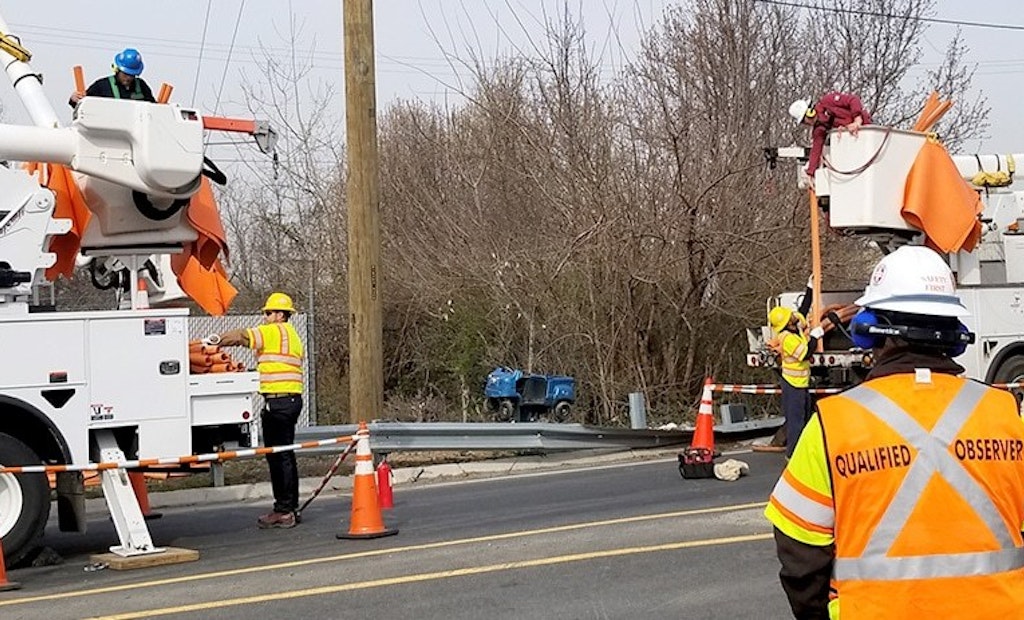Interested in Trucks?
Get Trucks articles, news and videos right in your inbox! Sign up now.
Trucks + Get AlertsCranes, aerials and bucket trucks are common sights in construction zones and among maintenance crews around cities. What better way to hoist materials to high places or to move workers closer to the task?
When your crew includes an aboveground operator in a bucket or cab, they’re linked to ground activity via a dedicated spotter. A spotter’s job is to free up the operator to focus on what they’re doing, uninterrupted from job site distractions.
Here are five ways to improve communication between these two.
1. Keep commands simple
The fewer commands being used, the better. Whether it’s OSHA’s standard method of hand signals or variations that your crew has put into practice, make sure visual signs and verbal cues are distinct from each other to avoid confusion. And decide — in advance — which ones you’ll be using.
Visual vs. verbal – The type of work and equipment you need to manage should dictate your mode of communication. A tower crane operator won’t always have their bellman in sight, but a cement truck traveling 20 feet in reverse is well within visual and voice range of a spotter, using mirrors and with windows rolled down.
Verbal is always the go-to choice when there’s more complex detail with work instructions. Communication devices work well on most job sites. Those that offer multichannel options allow for dedicated, private communication with the ability to include others, if you choose.
2. Know your daily checkpoints
We all like to know what’s on the day’s agenda. When you outline the day ahead with your crew, break it up into phases. Electrical linemen, for example, holler out when they’re done with one task and are moving on to the next. It keeps everyone alert as they advance to the next task. There’s no penalty for over-communication.
Productivity plus: When the team anticipates transitions, workflows become more seamless. People and equipment move into position as needed. Pieces of the puzzle fall into place.
Safety plus: Unexpected activities tend to stick out, like an unscheduled materials delivery coming into the work zone. Prevailing heads will know this is outside of the game plan and can call attention to it, keeping safety top of mind.
3. Let them know before you go
When your attention is diverted, call out to your buddy and wait for them to acknowledge that you’re stepping away. It happens. Someone approaches and assumes you’re the person in charge. If you’re spotting someone up in a bucket, try saying this: “Hey Bob, give me three minutes. I need to deal with this.”
And if you can’t see them or they can’t see you, just stop. Cranes on a construction site, for example, must follow the OSHA standard in this type of situation: During operations requiring signals, the ability to transmit signals between the operator and signal person must be maintained. If that ability is interrupted at any time, the operator must safely stop operations requiring signals until it is reestablished and a proper signal is given and understood. (Standard 1926.1419(f) for Cranes & Derricks in Construction, OSHA.)
4. Plan for an emergency
Motorcycle riders say this about an accident: it’s not if, it’s when. While that sounds potentially self-fulfilling, it’s actually the opposite. Safety advocates know that awareness is the gateway to participation, and fewer workers’ comp claims.
Experienced operators will review the job site to recognize potential hazards like unsettled or uneven terrain, and surrounding structures. Tight, urban work zones with less room and more obstructions need more contingencies than overhead wire pulls on a rural backroad.
And when the warning call goes out, know where it’s safe to quickly assemble. What are the major risks on your job site? Do a self-check using OSHA’s ongoing list based on actual incidents.
5. Spotter safety – look out for yourself
We’ve established that spotters help protect others, but who looks out for spotters? They do. And here’s how you can help them stay focused:
- Don’t give spotters extra responsibility, even if it looks like they’re not entirely engaged. A spotter that looks like she’s staring out into the distance may be scanning her buddy’s blind spots. If you must interrupt, approach slowly and make no assumptions that they’ll be able to actively engage with you right away.
- Encourage the use of high-visibility clothing, especially at night, that reacts to natural and artificial light. Well-fitted shirts, jackets, rain gear and gloves will keep you comfortable and get you noticed.
- Enforce a policy restricting phone use, earbuds and other distractions. Even a two-way radio on the hip can steal close attention between spotter and operator.
- If it’s critical that others contact the spotter on a radio device or the job requires coordinating between multiple operators, consider using a headset communication system that’ll allow hands-free use, to hear and talk with others.
To find out how Sonetics’ wireless communication solutions can help keep your crew connected and safe on the job site, please visit www.soneticscorp.com.






